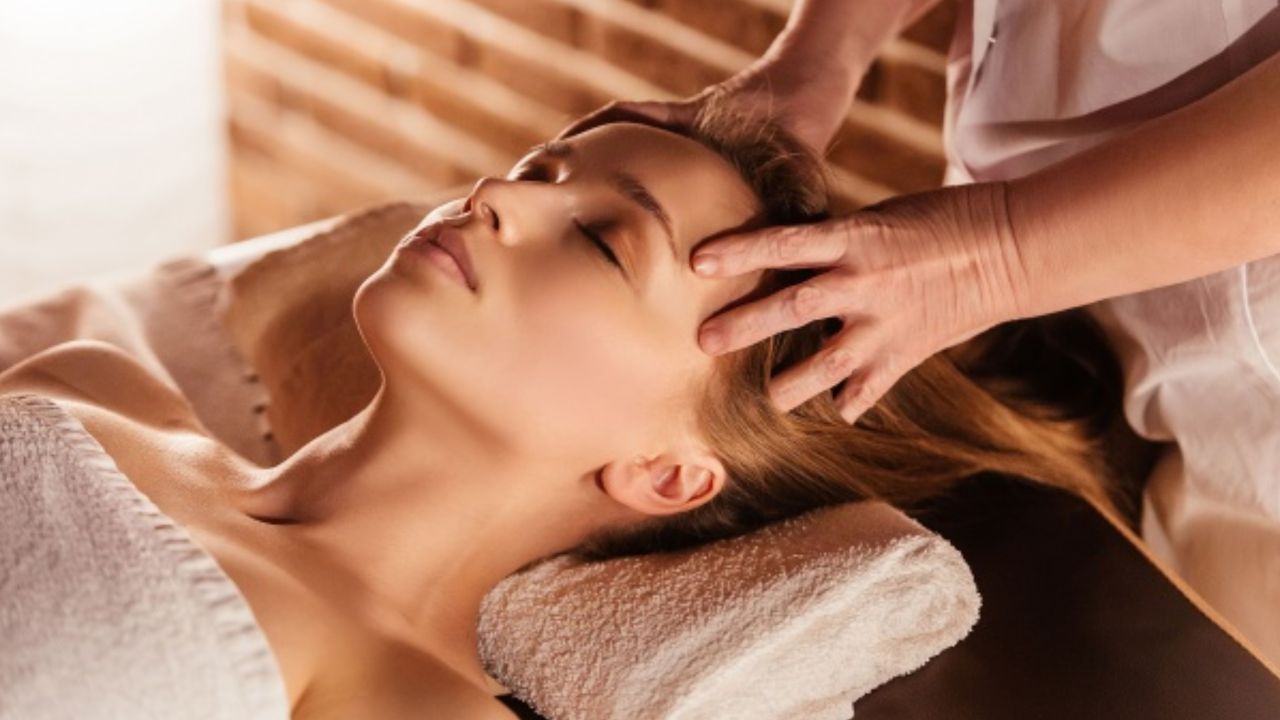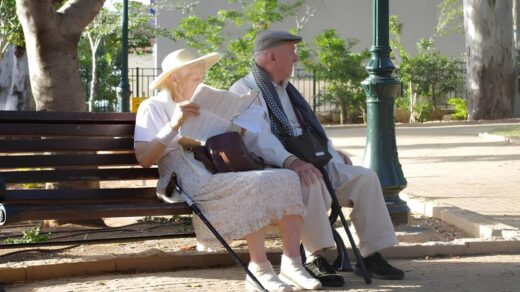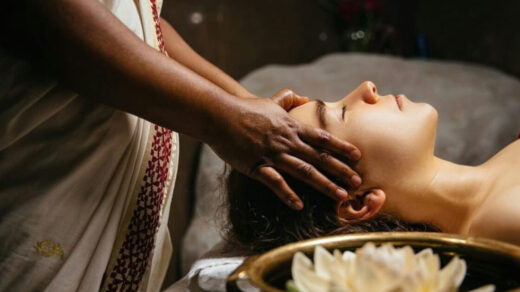Ayurvedic Head Massage: Benefits, Techniques, and More
In today’s fast-paced world, stress and anxiety have become commonplace. We’re constantly looking for ways to relax and rejuvenate, and one ancient practice that has gained popularity in recent years is Ayurvedic head massage. 
This traditional Indian therapy offers a myriad of benefits for both physical and mental well-being. In this comprehensive guide, we’ll explore the world of Ayurvedic head massage, its origins, techniques, benefits, and more.
What Is Ayurvedic Head Massage?
Ayurvedic head massage, often referred to as “Shiro Abhyanga” in Sanskrit, is a holistic healing practice deeply rooted in Ayurveda, the ancient Indian system of medicine. This therapeutic technique focuses on the head, neck, and shoulder areas, aiming to harmonize the body, mind, and spirit.
Ayurvedic head massage is a time-honored therapeutic treatment with a history of over 5000 years in India. This ancient practice employs a range of pressure techniques, including gentle circular massage strokes, targeting specific areas of your head, shoulders, and neck.
Through the skillful application of these deep massage techniques, often accompanied by the use of aromatic oils and Ayurvedic herbal blends, this treatment not only enhances the condition of your scalp and hair but also stimulates your body’s innate healing capabilities.
The Science Behind Ayurvedic Head Massage
Ayurvedic head massage, a cornerstone of Ayurvedic healing, operates on a profound understanding of the body’s inner workings. At its core, this ancient practice aims to harmonize the three doshas—Vata, Pitta, and Kapha—which are elemental forces governing various physiological and psychological aspects of our being.
Balancing the Doshas
In Ayurveda, the doshas represent a unique combination of the five elements—earth, water, fire, air, and ether—that make up our existence. Vata embodies air and ether, Pitta comprises fire and water, while Kapha encompasses earth and water.
Each individual has a distinct dosha constitution, and imbalances within these doshas can lead to various ailments. Ayurvedic head massage, through the precise application of pressure and oil, seeks to restore equilibrium among the doshas. By doing so, it not only addresses physical discomfort but also promotes emotional and mental well-being.
Promoting Prana Flow
Central to Ayurvedic head massage is the concept of prana, often referred to as the life force or vital energy. In Ayurveda, it is believed that the proper flow of prana throughout the body is essential for maintaining good health.
Any blockages or disturbances in this energy flow can lead to physical and mental imbalances. Ayurvedic head massage is designed to alleviate these blockages by stimulating specific Marma points on the head and neck.
These Marma points are believed to be junctions of energy where the body’s vital force can be accessed and redirected. Through gentle manipulation and the application of warm herbal oils, practitioners aim to free the flow of prana, promoting a sense of well-being and vitality.
The science behind Ayurvedic head massage isn’t merely theoretical; it’s rooted in centuries of observation and practice.
What Are Marmas Or Pressure Points?
According to Ayurveda, your body houses a network of 108 vital points known as ‘Marmas,’ with 31 of them located in the head region. These marmas serve as crucial pressure points where arteries, veins, and cranial nerves intersect.
Marmas can be likened to bi-directional emissary veins, playing a pivotal role in draining, cooling, and alleviating pressure within the head region. These points are integral to the practice of Ayurvedic head massage, as stimulating them effectively can lead to a range of therapeutic benefits.
The Key Head Marmas in Ayurveda
1. Adhipati: Located approximately 8 fingers width above the eyebrows, Adhipati is a soft spot at the center of the skull.
2. Simantaka: These are five suture joints spread across the scalp region.
3. Krikatika: Situated at the junction of the head and neck (occipital-cervical joint), there are two Krikatika points, one on each side of the cervical vertebrae.
4. Vidhuram: Behind and below both ears, you’ll find two Vidhuram points. These points are the slight depressions located just behind your earlobes.
5. Shankha: There are two Shankha points, each situated in the temples between the ears and the forehead.
6. Utkshepa: Found at the level of the scalp hairline just above the Shankha points, there are two Utkshepa points.
Tip: Ayurvedic head massages focus on these marmas or pressure points to enhance blood circulation within the emissary veins, scalp vasculature, and intracranial circulation.
This, in turn, promotes healthier and stronger hair growth, making Ayurvedic head massage a valuable practice for maintaining scalp and hair well-being.
Types of Ayurvedic Head Massages
1. Shirodhara
Shirodhara is a soothing Ayurvedic head massage technique where specific oils, such as sesame oil, lakshadi tailum, manjishtadi tailum, brahmi tailum, or shatavari tailum, are gently poured onto your forehead. In some cases, coconut water, milk, or ghee may also be used. This therapeutic head massage is renowned for its stress-relieving and headache-alleviating properties.
2. Shiro Abhyanga
Shiro Abhyanga is one of the most popular Ayurvedic head massages, renowned for its stress-relieving benefits. This technique focuses on massaging pressure points on the head, neck, and shoulder areas. The advantages of Shiro Abhyanga include pain relief, migraine management, muscle relaxation, improved vision, and relief from insomnia.
3. Shiro Vasti
Shiro Vasti, or Shiro Basti, involves pooling medicated Ayurvedic oils on the head. The term “Shiro” refers to the head, and “Vasti” implies container. This technique is prized for its ability to promote better sleep, balance the skull and brain, calm the mind, reduce anxiety, and support healthy hair growth.
4. Shiro Pichu
Shiro Pichu is another potent Ayurvedic head massage technique where the head area is saturated with Ayurvedic oils using a cotton cloth or pad. This treatment is known to enhance sleep quality, address scalp-related issues, boost memory, prevent hair fall, and tackle common hair problems.
Benefits of Ayurvedic Head Massage
1. Promotes Sound Sleep:
Ayurvedic head massage is known for its ability to relax the mind and body. By reducing stress and anxiety, it creates an environment conducive to sound and restful sleep. This is particularly beneficial for those who struggle with insomnia or irregular sleep patterns.
2. Strengthens Circulatory and Nervous Systems:
Through the gentle yet effective massage techniques applied during Ayurvedic head massage, blood circulation is improved. Enhanced circulation ensures that essential nutrients and oxygen reach the brain and scalp, promoting overall health.
Additionally, the massage stimulates nerve endings in the head, which can lead to improved nervous system functioning.
3. Stimulates Hair Growth:
Ayurvedic head massage involves the application of natural oils, which nourish the scalp and hair follicles. This nourishment, coupled with increased blood flow, can stimulate hair growth and help address issues like dandruff or hair loss. It also contributes to healthier, shinier hair.
4. Relieves Emotional and Mental Stress:
The soothing strokes and pressure points targeted during the massage alleviate emotional and mental stress. Tensions stored in the head, neck, and shoulders are released, leaving you with a profound sense of relaxation and mental clarity.
5. Reduces Depression and Anxiety:
Ayurvedic head massage has been shown to have a calming effect on the mind. Regular sessions can reduce symptoms of depression and anxiety by promoting a sense of inner peace and well-being.
6. Balances Hormone Levels:
Ayurvedic head massage is believed to have an impact on hormone regulation. By helping to balance hormone levels, it can contribute to overall hormonal health and well-being.
7. Promotes Release of Endorphins:
The massage encourages the release of endorphins, the body’s natural mood enhancers. These “feel-good” hormones create a sense of happiness and contentment, reducing feelings of stress and negativity.
8. Enhances Hair Shine:
Ayurvedic oils used in the massage deeply nourish the hair and scalp, leaving your hair looking vibrant and lustrous. This enhanced shine is a visible sign of improved hair health.
9. Rejuvenates Senses:
The overall experience of Ayurvedic head massage is deeply rejuvenating. It not only revitalizes your physical senses but also calms the mind. It’s an excellent way to unwind and escape the stresses of daily life.
10. Improves Alertness and Memory:
By enhancing blood circulation to the brain and reducing mental clutter, Ayurvedic head massage can improve alertness and memory. This heightened cognitive function can lead to increased productivity and mental clarity.
Step-by-Step Guide to Performing Ayurvedic Head Massage
Now that you’re aware of the benefits of Ayurvedic head massage and have chosen your preferred Ayurvedic oil, let’s explore how to perform a scalp massage to promote hair growth. Follow these steps for a soothing and effective scalp massage:
1. Prepare Your Oil: Begin by taking your favorite Ayurvedic oil and gently warming it. Ensure it’s comfortably warm, not hot, to avoid discomfort or burns.
2. Sit Upright: Sit with a straight posture to allow easy access to your scalp. Pour a small amount of warmed oil into your palm, ready for application.
3. Start at the Hairline: Begin by combing your fingers through your hair, starting from the hairline. Apply gentle pressure as you move your fingers through your scalp.
4. Focus on the Crown: Pour a bit more oil onto the crown of your head. Using gentle circular motions, massage the oil into this area and the sides of your head.
5. Tilt Forward: Bend your head forward gently, aiming for your chin to approach your chest. Pour a small amount of oil onto the back of your head, near the hairline. Using your finger pads, employ circular motions to massage this region.
6. Neck and Shoulders: Extend your fingers down to the back of your neck and shoulders. Continue massaging with circular finger strokes in this area, ensuring the entire back of your head and neck receives attention.
7. Full Scalp Massage: Now, apply firm but comfortable pressure to your entire scalp. Use circular strokes to massage your entire head thoroughly.
8. Leave Oil On: After the massage, leave the oil on your scalp for about twenty to thirty minutes. You can cover your head with a towel to protect it from dust and maintain warmth.
9. Optional Overnight Treatment: For a more intensive treatment, consider leaving the oil on overnight. In this case, wrap your head with a towel or place one on your pillow to prevent staining.
Self-Care: DIY Ayurvedic Head Massage
Self-care is a wonderful way to unwind and nourish your body and mind. A DIY Ayurvedic head massage is a fantastic self-care practice that can provide relaxation and rejuvenation in the comfort of your own space. Here’s how you can perform it:
1. Select Your Ayurvedic Oil: Begin by choosing a suitable Ayurvedic oil for your head massage. Options include sesame oil, coconut oil, brahmi tailum, or any other preferred Ayurvedic oil. Warm the oil gently to a comfortable temperature. Ensure it’s not too hot to avoid burns.
2. Find a Comfortable Seating Position: Sit in a quiet and comfortable place where you won’t be disturbed. You can use a chair or sit on the floor with a cushion for support.
3. Apply the Oil: Pour a small amount of warmed oil onto your palm. Start by applying the oil to your scalp. Use your fingertips to gently distribute the oil evenly across your entire scalp.
4. Massage Your Scalp: With the oil applied, use your fingertips to massage your scalp. Begin with gentle circular motions, moving from the front hairline to the back of your head. Apply a comfortable amount of pressure as you go along.
5. Focus on Pressure Points: Pay special attention to the pressure points on your head. These include the temples, the crown of your head, and the base of your skull. Apply a bit more pressure and circular movements in these areas.
6. Neck and Shoulders: Extend the massage to your neck and shoulders, which often carry tension. Use your fingertips or palms to massage these areas in circular or kneading motions.
7. Relax and Breathe: As you massage, take slow and deep breaths. This will help you relax further and enhance the calming effects of the massage.
8. Leave the Oil On: After the massage, leave the oil on your scalp and hair for at least twenty to thirty minutes. You can cover your head with a towel to prevent oil from dripping and to maintain warmth.
9. Shower or Wash: Finally, wash your hair with a mild shampoo to remove the oil. Enjoy the feeling of clean, nourished hair and a relaxed mind.
This DIY Ayurvedic head massage is an excellent way to pamper yourself and promote overall well-being. It can help alleviate stress, improve hair health, and bring a sense of calm and balance to your life.
Safety Precautions and Contraindications
While Ayurvedic head massage offers numerous benefits, it’s essential to practice it safely and be aware of certain contraindications to ensure your well-being. Here are some safety precautions and conditions to consider:
Safety Precautions:
1. Temperature of Oil: Always ensure that the oil you use is comfortably warm but not too hot. Testing the oil temperature on the inside of your wrist before applying it to your scalp is a good practice.
2. Allergic Reactions: If you have known allergies to specific oils or herbal ingredients, avoid using them in your Ayurvedic head massage oil. Choose oils that are safe for your skin type.
3. Gentle Pressure: Apply gentle and controlled pressure during the massage. Avoid excessive force, especially if you have a sensitive scalp.
4. Medical Consultation: If you have any underlying medical conditions, are pregnant, or have a history of head injuries, it’s advisable to consult with a healthcare professional before engaging in Ayurvedic head massage.
Contraindications:
1. Head Injuries: If you have recently suffered a head injury, it’s crucial to avoid any form of head massage until you have fully recovered. Consult a healthcare provider for guidance.
2. Open Wounds or Infections: Refrain from head massage if you have open wounds, infections, or skin conditions on your scalp, as it may worsen the condition or cause discomfort.
3. Fever or Illness: Avoid head massages when you are experiencing a fever or any acute illness. It’s best to rest and recover during such times.
4. Severe Scalp Conditions: If you have severe scalp conditions such as psoriasis, eczema, or dermatitis, consult a dermatologist before attempting an Ayurvedic head massage to ensure it won’t exacerbate the condition.
5. Recent Hair Treatments: If you’ve recently undergone hair treatments such as coloring, perming, or straightening, it’s advisable to wait until any chemical residues have completely washed out before engaging in a head massage.
6. Pregnancy: If you are pregnant, it’s essential to be cautious with any form of massage, including Ayurvedic head massage. Always consult with your healthcare provider before proceeding.
Frequently Asked Questions (FAQs)
Q1: What is the history of Ayurvedic head massage?
A1: The history of Ayurvedic head massage traces back to ancient India, where it was an integral part of Ayurvedic healing practices. Its origins can be found in ancient texts, and it has evolved over thousands of years.
Q2: Can Ayurvedic head massage cure migraines?
A2: While Ayurvedic head massage may not cure migraines, it can provide relief by reducing stress and promoting relaxation. It is often used as a complementary therapy for migraine management.
Q3: How often should I get an Ayurvedic head massage?
A3: The frequency of Ayurvedic head massages can vary depending on individual needs and preferences. Some people benefit from weekly sessions, while others may find monthly massages sufficient.
Q4: Are there any side effects of Ayurvedic head massage?
A4: Ayurvedic head massage is generally safe when performed by a trained therapist. However, some individuals may experience mild side effects like temporary discomfort or headaches. It’s essential to communicate any concerns with your therapist.
Q5: Can I perform self-massage if I have no prior experience?
A5: Yes, you can! We provide easy-to-follow self-massage techniques that anyone can practice, regardless of prior experience. Start with caution and gradually increase pressure as you become more comfortable.
Q6: How to give an Ayurvedic head massage?
A: To perform an Ayurvedic head massage, warm your chosen oil, apply it to your scalp, and use gentle circular motions to massage the head, focusing on pressure points. Seek guidance from a trained therapist for a more detailed technique.
Q7: Does Ayurvedic scalp massage work?
A: Yes, Ayurvedic scalp massage is known for its effectiveness in promoting hair and scalp health, reducing stress, and improving overall well-being.
Q8: What are the pressure points on the head in Ayurveda?
A: In Ayurveda, there are several pressure points on the head, including the temples, crown of the head, and base of the skull, which are often targeted during head massages for therapeutic benefits.
Q9: Which massage is good for the head?
A: Ayurvedic head massage is highly recommended for the head as it provides various health benefits, including stress relief, improved hair health, and relaxation.
Q10: Is head massage good for the brain?
A: Head massages can promote relaxation and reduce stress, which may indirectly benefit brain health. However, it’s not a direct treatment for brain-related conditions.
Q11: Can I massage my head daily?
A: Massaging your head daily is generally safe if done gently. However, it’s essential to listen to your body and avoid excessive pressure, especially if you experience discomfort.
Q12: What are the disadvantages of head massage?
A: While head massages offer numerous benefits, disadvantages may include mild side effects like temporary discomfort or headaches, particularly if the massage is too vigorous.
Q13: How many minutes should I massage my head?
A: A typical head massage can last anywhere from 15 to 30 minutes, but the duration can vary based on personal preference and comfort.
Q14: Are head massages healthy?
A: Yes, head massages are generally considered healthy as they promote relaxation, reduce stress, improve blood circulation, and enhance hair and scalp health. However, it’s essential to practice them safely and be aware of any contraindications.
Ayurvedic head massage offers a holistic approach to well-being, combining ancient wisdom with modern-day stress relief. Whether you choose to visit a professional therapist or practice self-massage at home, the benefits are profound. Embrace this time-tested tradition and experience the rejuvenation it can bring to your life.
References:
- Physical and Psychological Effects of Head Treatment in the Supine Position Using Specialized Ayurveda-Based Techniques(1)
- Using Indian head massage to aid recovery(2)
- The effect of a scalp massage on stress hormone, blood pressure, and heart rate of healthy female(3)
- Standardized Scalp Massage Results in Increased Hair Thickness by Inducing Stretching Forces to Dermal Papilla Cells in the Subcutaneous Tissue(5)

























